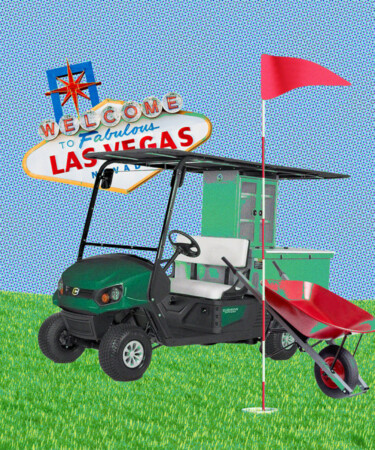Golf is easily one of the most popular hobbies in the United States. Once a sport relegated to the wealthy, golf has become much more widely accessible in recent years with an estimated one in every eight Americans playing a round every year. In 2023, over 531 million rounds of golf were played in the U.S. according to the PGA Tour — the fourth straight year when more than 500 million rounds were played. And while traversing all 18 holes, players are bound to get thirsty. That’s where the beverage cart comes in.
Roughly the same size as a standard golf cart, course beverage carts are exactly what they sound like — a bar on wheels. Equipped with coolers, hot boxes, and a small bar top, beverage carts are typically loaded with soda, water, and light provisions, along with an abundance of beer, liquor, and cocktail mixers.
This mobile merchandising is extremely lucrative, with the cart’s entire lifespan typically paid for within the first month of operation. After that, everything is “pure profit,” according to Golf Course Industry. As the magazine outlines, these carts can generate upwards of $1,000 in sales per day while out on the course, with that number jumping to over $5,000 on special-occasion days or during events. But how did they come to be? Turns out, the reason why so many golfers can drink on the course might have something to do with two members of the crooning Rat Pack.
As revealed during a TNT broadcast of “The Match” in November 2021, the beverage cart was created in Las Vegas sometime in the 1960s at The Desert Inn Golf Club. Now known as the Wynn Las Vegas, the club often hosted the famed Rat Pack — most notably Dean Martin, Frank Sinatra, and Sammy Davis Jr. — for rounds of golf. But Martin and Sinatra refused to play more than nine holes unless cocktails were provided. To persuade the musicians to play the full 18, club staff retrofitted a standard golf cart with a cooler, filled it with whatever drinks the two men wanted, and followed them around the course during their game.
It’s a fantastic story, but it’s one that’s difficult to prove, and similar refreshment services likely existed at other clubs around the world. Take The St. Andrews Golf Club in Scotland, for example. At the world’s oldest golf course, senior caddy David Anderson started offering golfers refreshments from an old wheelbarrow when he retired from caddying in 1856. Referring to his refreshment “cart” as the “19th Hole,” the wheelbarrow was stocked with ginger beer, milk, and light snacks, though many believe that Scotch whisky was also on offer.
Whether the cart originated in Scotland in the 1850s or in Las Vegas in the 1960s, we couldn’t be more grateful for its existence — especially when in need of a mid-round Transfusion.
*Image retrieved from hicham – stock.adobe.com
